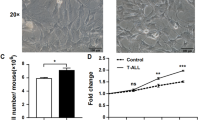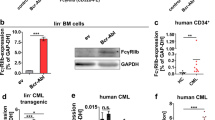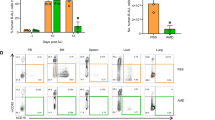Abstract
The bone marrow (BM) stromal niche can protect acute lymphoblastic leukemia (ALL) cells against the cytotoxicity of chemotherapeutic agents and is a possible source of relapse. The stromal-derived factor-1 (SDF-1)/CXCR4 axis is a major determinant in the crosstalk between leukemic cells and BM stroma. In this study, we investigated the use of AMD11070, an orally available, small-molecule antagonist of CXCR4, as an ALL-sensitizing agent. This compound effectively blocked stromal-induced migration of human ALL cells in culture and disrupted pre-established adhesion to stroma. To examine how to optimally use this compound in vivo, several combinations with cytotoxic drugs were tested in a stromal co-culture system. The best treatment regimen was then tested in vivo. Mice transplanted with murine Bcr/Abl ALL cells survived significantly longer when treated with a combination of nilotinib and AMD11070. Similarly, immunocompromised mice transplanted with human ALL cells and treated with vincristine and AMD11070 had few circulating leukemic cells, normal spleens and reduced human CD19+ cells in the BM at the termination of the experiment. These results show that combined treatment with AMD11070 may be of significant benefit in eradicating residual leukemia cells at locations where they would otherwise be protected by stroma.
This is a preview of subscription content, access via your institution
Access options
Subscribe to this journal
Receive 12 print issues and online access
$259.00 per year
only $21.58 per issue
Buy this article
- Purchase on Springer Link
- Instant access to full article PDF
Prices may be subject to local taxes which are calculated during checkout






Similar content being viewed by others
References
Jemal A, Tiwari RC, Murray T, Ghafoor A, Samuels A, Ward E et al. Cancer statistics, 2004. CA Cancer J Clin 2004; 54: 8–29.
Fullmer A, O’Brien S, Kantarjian H, Jabbour E . Novel therapies for relapsed acute lymphoblastic leukemia. Curr Hematol Malig Rep 2009; 4: 148–156.
Sadowitz PD, Smith SD, Shuster J, Wharam MD, Buchanan GR, Rivera GK . Treatment of late bone marrow relapse in children with acute lymphoblastic leukemia: a Pediatric Oncology Group study. Blood 1993; 81: 602–609.
Pui CH, Evans WE . Treatment of acute lymphoblastic leukemia. N Engl J Med 2006; 354: 166–178.
Gaynon PS . Childhood acute lymphoblastic leukaemia and relapse. Br J Haematol 2005; 131: 579–587.
Ottmann OG, Druker BJ, Sawyers CL, Goldman JM, Reiffers J, Silver RT et al. A phase 2 study of imatinib in patients with relapsed or refractory Philadelphia chromosome-positive acute lymphoid leukemias. Blood 2002; 100: 1965–1971.
Druker BJ, Sawyers CL, Kantarjian H, Resta DJ, Reese SF, Ford JM et al. Activity of a specific inhibitor of the BCR-ABL tyrosine kinase in the blast crisis of chronic myeloid leukemia and acute lymphoblastic leukemia with the Philadelphia chromosome. N Engl J Med 2001; 344: 1038–1042.
Nagasawa T . Microenvironmental niches in the bone marrow required for B-cell development. Nat Rev 2006; 2: 107–116.
Bradstock K, Bianchi A, Makrynikola V, Filshie R, Gottlieb D . Long-term survival and proliferation of precursor-B acute lymphoblastic leukemia cells on human bone marrow stroma. Leukemia 1996; 10: 813–820.
Bradstock KF, Makrynikola V, Bianchi A, Shen W, Hewson J, Gottlieb DJ . Effects of the chemokine stromal cell-derived factor-1 on the migration and localization of precursor-B acute lymphoblastic leukemia cells within bone marrow stromal layers. Leukemia 2000; 14: 882–888.
Mishra S, Zhang B, Cunnick JM, Heisterkamp N, Groffen J . Resistance to imatinib of bcr/abl p190 lymphoblastic leukemia cells. Cancer Res 2006; 66: 5387–5393.
Burger JA, Tsukada N, Burger M, Zvaifler NJ, Dell’Aquila M, Kipps TJ . Blood-derived nurse-like cells protect chronic lymphocytic leukemia B cells from spontaneous apoptosis through stromal cell-derived factor-1. Blood 2000; 96: 2655–2663.
Manabe A, Murti KG, Coustan-Smith E, Kumagai M, Behm FG, Raimondi SC et al. Adhesion-dependent survival of normal and leukemic human B lymphoblasts on bone marrow stromal cells. Blood 1994; 83: 758–766.
Ponomaryov T, Peled A, Petit I, Taichman RS, Habler L, Sandbank J et al. Induction of the chemokine stromal-derived factor-1 following DNA damage improves human stem cell function. J Clin Invest 2000; 106: 1331–1339.
Imai K, Kobayashi M, Wang J, Shinobu N, Yoshida H, Hamada J et al. Selective secretion of chemoattractants for haemopoietic progenitor cells by bone marrow endothelial cells: a possible role in homing of haemopoietic progenitor cells to bone marrow. Br J Haematol 1999; 106: 905–911.
Nagasawa T, Kikutani H, Kishimoto T . Molecular cloning and structure of a pre-B-cell growth-stimulating factor. Proc Natl Acad Sci USA 1994; 91: 2305–2309.
Glodek AM, Le Y, Dykxhoorn DM, Park SY, Mostoslavsky G, Mulligan R et al. Focal adhesion kinase is required for CXCL12-induced chemotactic and pro-adhesive responses in hematopoietic precursor cells. Leukemia 2007; 8: 1723–1732.
Ara T, Itoi M, Kawabata K, Egawa T, Tokoyoda K, Sugiyama T et al. A role of CXC chemokine ligand 12/stromal cell-derived factor-1/pre-B cell growth stimulating factor and its receptor CXCR4 in fetal and adult T cell development in vivo. J Immunol 2003; 170: 4649–4655.
Juarez JG, Thien M, Dela Pena A, Baraz R, Bradstock KF, Bendall LJ . CXCR4 mediates the homing of B cell progenitor acute lymphoblastic leukaemia cells to the bone marrow via activation of p38MAPK. Br J Haematol 2009; 145: 491–499.
Bendall LJ, Baraz R, Juarez J, Shen W, Bradstock KF . Defective p38 mitogen-activated protein kinase signaling impairs chemotaxic but not proliferative responses to stromal-derived factor-1alpha in acute lymphoblastic leukemia. Cancer Res 2005; 65: 3290–3298.
Spiegel A, Kollet O, Peled A, Abel L, Nagler A, Bielorai B et al. Unique SDF-1-induced activation of human precursor-B ALL cells as a result of altered CXCR4 expression and signaling. Blood 2004; 103: 2900–2907.
Juarez J, Bradstock KF, Gottlieb DJ, Bendall LJ . Effects of inhibitors of the chemokine receptor CXCR4 on acute lymphoblastic leukemia cells in vitro. Leukemia 2003; 17: 1294–1300.
Kawaguchi A, Orba Y, Kimura T, Iha H, Ogata M, Tsuji T et al. Inhibition of the SDF-1alpha-CXCR4 axis by the CXCR4 antagonist AMD3100 suppresses the migration of cultured cells from ATL patients and murine lymphoblastoid cells from HTLV-I Tax transgenic mice. Blood 2009; 114: 2961–2968.
Nervi B, Ramirez P, Rettig MP, Uy GL, Holt MS, Ritchey JK et al. Chemosensitization of acute myeloid leukemia (AML) following mobilization by the CXCR4 antagonist AMD3100. Blood 2009; 113: 6206–6214.
Devine SM, Flomenberg N, Vesole DH, Liesveld J, Weisdorf D, Badel K et al. Rapid mobilization of CD34+ cells following administration of the CXCR4 antagonist AMD3100 to patients with multiple myeloma and non-Hodgkin's lymphoma. J Clin Oncol 2004; 22: 1095–1102.
Zeng Z, Shi YX, Samudio IJ, Wang RY, Ling X, Frolova O et al. Targeting the leukemia microenvironment by CXCR4 inhibition overcomes resistance to kinase inhibitors and chemotherapy in AML. Blood 2009; 113: 6215–6224.
Tavor S, Eisenbach M, Jacob-Hirsch J, Golan T, Petit I, Benzion K et al. The CXCR4 antagonist AMD3100 impairs survival of human AML cells and induces their differentiation. Leukemia 2008; 22: 2151–2158.
Liles WC, Broxmeyer HE, Rodger E, Wood B, Hübel K, Cooper S et al. Mobilization of hematopoietic progenitor cells in healthy volunteers by AMD3100, a CXCR4 antagonist. Blood 2003; 102: 2728–2730.
Zeng Z, Shi YX, Samudio IJ, Wang RY, Ling X, Frolova O et al. Targeting the leukemia microenvironment by CXCR4 inhibition overcomes resistance to kinase inhibitors and chemotherapy in AML. Blood 2009; 113: 6215–6224.
Heisterkamp N, Groffen J . BCR/ABL gene structure and BCR function. In: Carella AM, Daley GQ, Eaves CJ, Goldman JM, Hehlman R (eds). Chronic Myeloid Leukemia: Biology and Treatment. Martin Dunitz Ltd: London, UK, 2001, pp 3–17.
Dillmann F, Veldwijk MR, Laufs S, Sperandio M, Calandra G, Wenz F et al. Plerixafor inhibits chemotaxis toward SDF-1 and CXCR4-mediated stroma contact in a dose-dependent manner resulting in increased susceptibility of BCR-ABL+ cell to Imatinib and Nilotinib. Leuk Lymphoma 2009; 50: 1676–1686.
Vianello F, Villanova F, Tisato V, Lymperi S, Ho KK, Gomes AR et al. Bone marrow mesenchymal stromal cells non-selectively protect chronic myeloid leukemia cells from imatinib-induced apoptosis via the CXCR4/CXCL12 axis. Haematologica 2010; 95: 1081–1089.
Hendrix CW, Flexner C, MacFarland RT, Giandomenico C, Fuchs EJ, Redpath E et al. Pharmacokinetics and safety of AMD-3100, a novel antagonist of the CXCR-4 chemokine receptor, in human volunteers. Antimicrob Agents Chemother 2000; 44: 1667–1673.
Moyle G, DeJesus E, Boffito M, Wong RS, Gibney C, Badel K et al. Proof of activity with AMD11070, an orally bioavailable inhibitor of CXCR4-tropic HIV type 1. Clin Infect Dis 2009; 48: 798–805.
Stone ND, Dunaway SB, Flexner C, Tierney C, Calandra GB, Becker S et al. Multiple-dose escalation study of the safety, pharmacokinetics, and biologic activity of oral AMD070, a selective CXCR4 receptor inhibitor, in human subjects. Antimicrob Agents Chemother 2007; 51: 2351–2358.
Baersch G, Mollers T, Hotte A, Dockhorn-Dworniczak B, Rube C, Ritter J et al. Good engraftment of B-cell precursor ALL in NOD-SCID mice. Klin Padiatr 1997; 209: 178–185.
Parameswaran R, Müschen M, Kim YM, Groffen J, Heisterkamp N . A functional receptor for B-cell activating factor is expressed on human acute lymphoblastic leukemias. Cancer Res 2010; 70: 4346–4356.
Fei F, Stoddart S, Groffen J, Heisterkamp N . Activity of the Aurora kinase inhibitor VX-680 against Bcr/Abl-positive acute lymphoblastic leukemias. Mol Cancer Ther 2010; 9: 1318–1327.
Kaur P, Feldhahn N, Zhang B, Trageser D, Müschen M, Pertz V et al. Nilotinib treatment in mouse models of P190 Bcr/Abl lymphoblastic leukemia. Mol Cancer 2007; 6: 67.
De Clercq E . Inhibition of HIV infection by bicyclams, highly potent and specific CXCR4 antagonists. Mol Pharmacol 2000; 57: 833–839.
Crazzolara R, Kreczy A, Mann G, Heitger A, Eibl G, Fink FM et al. High expression of the chemokine receptor CXCR4 predicts extramedullary organ infiltration in childhood acute lymphoblastic leukaemia. Br J Haematol 2001; 115: 545–553.
Wong RS, Bodart V, Metz M, Labrecque J, Bridger G, Fricker SP . Comparison of the potential multiple binding modes of bicyclam, monocylam, and noncyclam small-molecule CXC chemokine receptor 4 inhibitors. Mol Pharmacol 2008; 74: 1485–1495.
Drummond MW, Heaney N, Kaeda J, Nicolini FE, Clark RE, Wilson G et al. A pilot study of continuous imatinib vs pulsed imatinib with or without G-CSF in CML patients who have achieved a complete cytogenetic response. Leukemia 2009; 23: 1199–1201.
Orimo A, Gupta PB, Sgroi DC, Arenzana-Seisdedos F, Delaunay T, Naeem R et al. Stromal fibroblasts present in invasive human breast carcinomas promote tumor growth and angiogenesis through elevated SDF-1/CXCL12 secretion. Cell 2005; 121: 335–348.
Geminder H, Sagi-Assif O, Goldberg L, Meshel T, Rechavi G, Witz IP et al. A possible role for CXCR4 and its ligand, the CXC chemokine stromal cell-derived factor-1, in the development of bone marrow metastases in neuroblastoma. J Immunol 2001; 167: 4747–4757.
Burger JA, Peled A . CXCR4 antagonists: targeting the microenvironment in leukemia and other cancers. Leukemia 2009; 23: 43–52.
Scala S, Ottaiano A, Ascierto PA, Cavalli M, Simeone E, Giuliano P et al. Expression of CXCR4 predicts poor prognosis in patients with malignant melanoma. Clin Cancer Res 2005; 11: 1835–1841.
Zeelenberg IS, Ruuls-Van Stalle L, Roos E . The chemokine receptor CXCR4 is required for outgrowth of colon carcinoma micrometastases. Cancer Res 2003; 63: 3833–3839.
Burger JA, Kipps TJ . CXCR4: a key receptor in the crosstalk between tumor cells and their microenvironment. Blood 2006; 107: 1761–1767.
Wang J, Wang J, Sun Y, Song W, Nor JE, Wang CY et al. Diverse signaling pathways through the SDF-1/CXCR4 chemokine axis in prostate cancer cell lines leads to altered patterns of cytokine secretion and angiogenesis. Cell Signal 2005; 17: 1578–1592.
Acknowledgements
We thank Donna Foster for excellent care of the mice. This work was supported by PHS Grants CA090321 (to NH) and by the William Lawrence & Blanche Hughes Foundation (NH, JG).
Author information
Authors and Affiliations
Corresponding author
Ethics declarations
Competing interests
The authors declare no conflict of interest.
Additional information
Supplementary Information accompanies the paper on the Leukemia website
Rights and permissions
About this article
Cite this article
Parameswaran, R., Yu, M., Lim, M. et al. Combination of drug therapy in acute lymphoblastic leukemia with a CXCR4 antagonist. Leukemia 25, 1314–1323 (2011). https://doi.org/10.1038/leu.2011.76
Received:
Revised:
Accepted:
Published:
Issue Date:
DOI: https://doi.org/10.1038/leu.2011.76
Keywords
This article is cited by
-
Targeting chemokines for acute lymphoblastic leukemia therapy
Journal of Hematology & Oncology (2021)
-
Chemokine level predicts the therapeutic effect of anti-PD-1 antibody (nivolumab) therapy for malignant melanoma
Archives of Dermatological Research (2021)
-
A phase 1b trial of the CXCR4 inhibitor mavorixafor and nivolumab in advanced renal cell carcinoma patients with no prior response to nivolumab monotherapy
Investigational New Drugs (2021)
-
Treatment of B-cell precursor acute lymphoblastic leukemia with the Galectin-1 inhibitor PTX008
Journal of Experimental & Clinical Cancer Research (2018)
-
Enhancement of the CXCL12/CXCR4 axis due to acquisition of gemcitabine resistance in pancreatic cancer: effect of CXCR4 antagonists
BMC Cancer (2016)



